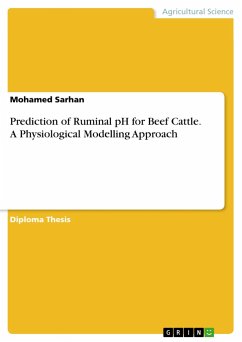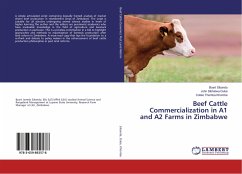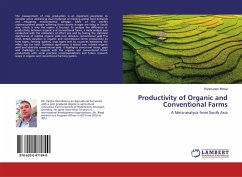Diploma Thesis from the year 2015 in the subject Agrarian Studies, grade: 108/110, Université Paul-Valéry Montpellier 3 (Institut National de la Recherche Agronomique), course: Management of Animal Resources and Sustainable Development in Agriculture, language: English, abstract: Ruminal fluid pH (RpH) is an important parameter for controlling the rumen functions. The ability to predict the RpH of beef cattle fed a given diet without depending on the invasive techniques for its measurements (i.e., rumen cannula) is important to avoid ruminal acidosis. The objectives of this research were to: (i) identify key variables that have a significant associations with RpH; (ii) collect data points (DB) from in-vivo beef cattle studies to identify suitable predictors of RpH after considering the animal measures and the dietary variables from a wide range of diets that can safely be fed to beef cattle; (iii) evaluate the extant RpH models relevant to the study; and (iv) develop a new statistical models for mean RpH predictions. Therefore, feed additives (i.e., monensin) were excluded from the analysis. Models tested that use physically effective fiber (peNDF) as a dependent variable were Pitt et al. (1996, PIT), Mertens (1997, MER), Fox et al. (2004, FOX), Zebeli et al. (2006, ZB6), and Zebeli et al. (2008, ZB8), and those that use rumen volatile fatty acids (VFAs) were Tamminga and Van Vuuren (1988, TAM), Lescoat and Sauvant (1995, LES), and Allen (1997, ALL). The final database was categorized into DB (1) and (2) that included a total of 232 and 95 treatment means from 65 and 26 peer-reviewed publications, respectively, spanning from the 1969s to 2014. The DB included information on animal characteristics, ration composition, and ruminal fermentation and pH, that has been used for independent evaluation and development of RpH prediction models. The average bodyweight was 437±168 vs.556±114 kg, dry matter intake (DMI) was 8.
Hinweis: Dieser Artikel kann nur an eine deutsche Lieferadresse ausgeliefert werden.
Hinweis: Dieser Artikel kann nur an eine deutsche Lieferadresse ausgeliefert werden.








